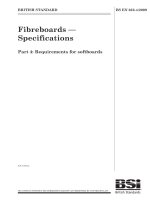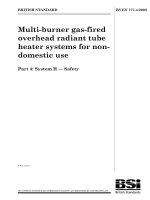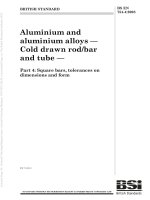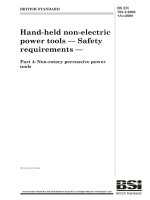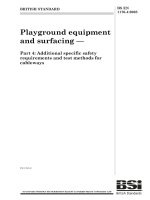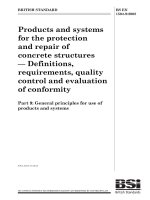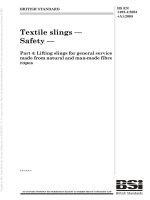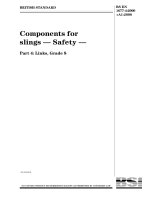Bsi bs en 01367 4 2008 (2009)
Bạn đang xem bản rút gọn của tài liệu. Xem và tải ngay bản đầy đủ của tài liệu tại đây (814.26 KB, 18 trang )
BRITISH STANDARD
Tests for thermal and
weathering properties
of aggregates
Part 4: Determination of drying
shrinkage
ICS 91.100.15
NO COPYING WITHOUT BSI PERMISSION EXCEPT AS PERMITTED BY COPYRIGHT LAW
BS EN
1367-4:2008
BS EN 1367-4:2008
National foreword
This British Standard is the UK implementation of EN 1367-4:2008. It
supersedes BS EN 1367-4:1998 which is withdrawn.
The UK participation in its preparation was entrusted to Technical
Committee B/502/6, Test methods.
A list of organizations represented on this committee can be obtained on
request to its secretary.
This publication does not purport to include all the necessary provisions
of a contract. Users are responsible for its correct application.
Compliance with a British Standard cannot confer immunity
from legal obligations.
This British Standard was
published under the
authority of the Standards
Policy and Strategy
Committee on 30 June
2009
© BSI 2009
ISBN 978 0 580 58932 4
Amendments/corrigenda issued since publication
Date
Comments
BS EN 1367-4:2008
EN 1367-4
EUROPEAN STANDARD
NORME EUROPÉENNE
EUROPÄISCHE NORM
March 2008
ICS 91.100.15
Supersedes EN 1367-4:1998
English Version
Tests for thermal and weathering properties of aggregates - Part
4: Determination of drying shrinkage
Essais pour déterminer les propriétés thermiques et
l'altérabilité des granulats - Partie 4: Determination du
retrait au séchage
Prüfverfahren für thermische Eigenschaften und
Verwitterungsbeständigkeit von Gesteinskörnungen - Teil 4:
Bestimmung der Trockenschwindung
This European Standard was approved by CEN on 4 February 2008.
CEN members are bound to comply with the CEN/CENELEC Internal Regulations which stipulate the conditions for giving this European
Standard the status of a national standard without any alteration. Up-to-date lists and bibliographical references concerning such national
standards may be obtained on application to the CEN Management Centre or to any CEN member.
This European Standard exists in three official versions (English, French, German). A version in any other language made by translation
under the responsibility of a CEN member into its own language and notified to the CEN Management Centre has the same status as the
official versions.
CEN members are the national standards bodies of Austria, Belgium, Bulgaria, Cyprus, Czech Republic, Denmark, Estonia, Finland,
France, Germany, Greece, Hungary, Iceland, Ireland, Italy, Latvia, Lithuania, Luxembourg, Malta, Netherlands, Norway, Poland, Portugal,
Romania, Slovakia, Slovenia, Spain, Sweden, Switzerland and United Kingdom.
EUROPEAN COMMITTEE FOR STANDARDIZATION
COMITÉ EUROPÉEN DE NORMALISATION
EUROPÄISCHES KOMITEE FÜR NORMUNG
Management Centre: rue de Stassart, 36
© 2008 CEN
All rights of exploitation in any form and by any means reserved
worldwide for CEN national Members.
B-1050 Brussels
Ref. No. EN 1367-4:2008: E
BS EN 1367-4:2008
EN 1367-4:2008 (E)
Contents
Page
Foreword..............................................................................................................................................................3
1
Scope ......................................................................................................................................................4
2
Normative references ............................................................................................................................4
3
Terms and definitions ...........................................................................................................................4
4
Principle..................................................................................................................................................5
5
Sampling.................................................................................................................................................5
6
Apparatus ...............................................................................................................................................5
7
Materials .................................................................................................................................................6
8
Preparation of test subsamples ............................................................................................................6
9
Preparation of test prisms .....................................................................................................................7
10
Procedure .............................................................................................................................................10
11
Calculation and expression of results ................................................................................................10
12
Test report ............................................................................................................................................11
Annex A (informative) Conditions of larger aggregate size ...........................................................................12
Annex B (informative) Precision ......................................................................................................................13
Bibliography ......................................................................................................................................................14
2
BS EN 1367-4:2008
EN 1367-4:2008 (E)
Foreword
This document (EN 1367-4:2008) has been prepared by Technical Committee CEN/TC 154 “Aggregates”, the
secretariat of which is held by BSI.
This European Standard shall be given the status of a national standard, either by publication of an identical
text or by endorsement, at the latest by September 2008, and conflicting national standards shall be
withdrawn at the latest by September 2008.
Attention is drawn to the possibility that some of the elements of this document may be the subject of patent
rights. CEN [and/or CENELEC] shall not be held responsible for identifying any or all such patent rights.
This document supersedes EN 1367-4:1998.
Testing in accordance with this standard is intended to provide information to assist in judging the performance
of aggregates subject to weathering action. This standard is intended to identify aggregates with high moisture
sensitivity which in concrete may cause excessive cracking, deflection and loss of durability. This test may not be
suitable for lightweight aggregates.
This European Standard is one of a series of tests for thermal and weathering properties of aggregates as listed
below.
EN 1367-1, Tests for thermal and weathering properties of aggregates - Part 1: Determination of resistance to
freezing and thawing
EN 1367-2, Tests for thermal and weathering properties of aggregates - Part 2: Magnesium sulfate test
EN 1367-3, Tests for thermal and weathering properties of aggregates - Part 3: Boiling test for "Sonnenbrand
basalt"
EN 1367-5, Tests for thermal and weathering properties of aggregates - Part 5: Determination of resistance to
thermal shock
Test methods for other properties of aggregates will be covered by Parts of the following European Standards:
EN 932, Tests for general properties of aggregates
EN 933, Tests for geometrical properties of aggregates
EN 1097, Tests for mechanical and physical properties of aggregates
EN 1744, Tests for chemical properties of aggregates
EN 13179, Tests for filler aggregate used in bituminous mixtures
According to the CEN/CENELEC Internal Regulations, the national standards organizations of the following
countries are bound to implement this European Standard: Austria, Belgium, Bulgaria, Cyprus, Czech
Republic, Denmark, Estonia, Finland, France, Germany, Greece, Hungary, Iceland, Ireland, Italy, Latvia,
Lithuania, Luxembourg, Malta, Netherlands, Norway, Poland, Portugal, Romania, Slovakia, Slovenia, Spain,
Sweden, Switzerland and the United Kingdom.
3
BS EN 1367-4:2008
EN 1367-4:2008 (E)
1
Scope
This standard describes the reference method used for type testing and in cases of dispute, for determining the
effect of aggregates on the drying shrinkage of concrete. For other purposes, in particular factory production
control, other methods may be used provided an appropriate working relationship with the reference method has
been established.
This standard is based on the testing of concretes of fixed mix proportions and aggregates of 20 mm maximum
size.
NOTE 1 Guidance on the use of larger size is given in Annex A. Precision data is not available for variations in size and for
variations in the water content of the test concrete.
NOTE 2 In those cases where the drying shrinkage of a source of coarse aggregate only or a source of fine aggregate
(sand) only are required, the other component to be used should be, respectively, a fine or coarse aggregate of known low
shrinkage.
NOTE 3 Aggregates with high water demand and/or porosity may in a concrete with a fixed water content result in a mix
with insufficient workability to allow full compaction of the test specimens. This is likely to occur with aggregates combinations
having a composite water absorption value greater than 3,5% or oven-dried particle densities less than 2,45 Mg/m³ (e.g. for
recycled aggregates). In such instances a variation of the method (without precision data) may be carried out by one of the
following changes to the concrete mix:
(a) use of aggregates in the saturated and surface dry condition.
(b) use of water-reducing admixture.
A note on the details of any modification to the mix design should be included with the test report.
2
Normative references
The following referenced documents are indispensable for the application of this document. For dated
references, only the edition cited applies. For undated references, the latest edition of the referenced
document (including any amendments) applies.
EN 197-1 Cement - Part 1: Composition, specifications and conformity criteria for common cements
EN 932-1, Tests for general properties of aggregates - Part 1: Methods for sampling
EN 932-2, Tests for general properties of aggregates - Part 2: Methods for reducing laboratory samples
EN 932-5, Tests for general properties of aggregates - Part 5: Common equipment and calibration
EN 933-2, Tests for geometrical properties of aggregates - Part 2: Determination of particle size distribution Test sieves, nominal size of apertures
3
Terms and definitions
For the purposes of this document, the following terms and definitions apply.
3.1
laboratory sample
sample intended for laboratory testing
NOTE
4
The laboratory sample is generally the penultimate stage in a multi-stage sampling procedure.
BS EN 1367-4:2008
EN 1367-4:2008 (E)
3.2
subsample
sample obtained from sampling increments or a bulk sample by means of a sample reduction procedure
3.3
test portion
sample used as a whole in a single test
4
Principle
The aggregate under test is mixed with cement and water and cast into prisms of specified dimensions. The
prisms are subjected to wetting followed by drying at (110 ± 5) °C and the change in length from the wet to the
dry state is determined. The excess drying shrinkage of the concrete is attributed to the aggregate, and is
expressed as the average change in length of the prisms, as a percentage of their final dry lengths.
5
Sampling
The laboratory sample to be used for the test shall be taken in accordance with EN 932-1.
6
Apparatus
Unless otherwise stated, all apparatus shall conform to the general requirements of EN 932-5.
6.1
Sample divider, of size appropriate to the maximum particle size to be handled or, alternatively, a flat
shovel and a clean, hard horizontal surface, e.g. a metal tray for use in quartering.
6.2
Test sieves, conforming to EN 933-2, appropriate to the sizes of aggregate to be tested.
6.3
Balance, of minimum capacity 5 kg and minimum accuracy of 0,1 %.
6.4
Single or gang moulds, suitable for casting three concrete prisms of dimensions (200 ± 2) mm x (50 ± 2)
mm x (50 ± 2) mm with 8 mm diameter stainless steel balls or hemispherical buttons or recessed inserts,
securely fixed to the centre of the inside faces of the 50 mm x 50 mm ends of the mould.
6.5
Vibrating table, capable of fully compacting the concrete in the moulds.
6.6
Measuring apparatus, incorporating a dial gauge with scale divisions of 0,002 mm and having a maximum
error of ± 0,002 mm in any half revolution. This gauge shall be rigidly mounted in a measuring frame and shall
have a recessed end which can be located on 8 mm diameter stainless steel balls or hemispherical buttons or
inserts cemented in the prisms (see 9.3). The other end of the frame shall have a similar recessed seating,
which can be located upon balls in the opposite end of the prisms.
A reference alloy steel rod of low thermal expansion, (205 ± 1) mm long, with 6 mm hemispherical ends shall be
used as a standard of length against which the readings of the gauge can be tested, thus enabling corrections to
be made for any changes in the dimensions of the apparatus between successive measurements of the prisms.
The reference rod shall be marked so that the same end can be kept uppermost during measurements.
NOTE
Alternative measuring devices can be used in place of the dial gauge, e.g. linear variable differential transducers,
provided they are of at least equal performance and fitted with seatings compatible with the stainless steel balls or inserts as
appropriate.
5
BS EN 1367-4:2008
EN 1367-4:2008 (E)
6.7
Ventilated oven, thermostatically controlled and capable of maintaining temperatures of (50 ± 2) °C and
(110 ± 5) °C.
NOTE
6.8
Different ovens for each temperature range can be used.
Thermometer, capable of measuring the oven temperatures of 50 °C and 110 °C to a precision of 0,5 °C.
6.9
Desiccators, large enough to contain three concrete prisms 200 mm x 50 mm x 50 mm containing
anhydrous silica gel as the desiccant.
6.10 Trays, that are capable of being heated in the ventilated oven without damage or change in mass.
6.11 Timing device, such that the full range of timed periods can be measured to an accuracy of ± 1 min.
6.12 Mechanical mixer, capable of mixing all constituents thoroughly within the specified time limits.
NOTE
Alternatively hand mixing can be used.
6.13 Flat impervious cover sheet, of suitable size, of rubber, polythene or steel.
7
Materials
7.1
Cement, conforming to type CEM 1 Class 42,5 of EN 197-1.
7.2
Water, distilled or de-ionised.
7.3
8 mm diameter stainless steel balls or hemispherical buttons or inserts (see 6.4).
8
Preparation of test subsamples
8.1
Reduce the laboratory samples of the coarse and fine aggregate (sand) by the procedure specified in
EN 932-2 to produce subsamples that can be sieved after oven drying to give approximately 1 600 g of 10 mm
to 20 mm size fraction, 800 g of 4 mm to 10 mm size fraction and 1 300 g of 0 mm to 4 mm fine aggregate
(sand).
8.2
8.3
Spread the subsamples on shallow trays and dry for at least 16 h in the oven (see 6.7) set at (50 ± 2) °C.
Reject all oversize material from the fine aggregate (sand) and all oversize and undersize material from
each of the two coarse aggregate subsamples.
6
BS EN 1367-4:2008
EN 1367-4:2008 (E)
9
9.1
Preparation of test prisms
Proportioning
Cast three test prisms, using the amount of cement, aggregates and water required to make the three prisms as
specified in Table 1.
Table 1 - Masses of constituents in test prisms
Constituent
Cement
Coarse aggregate (20 mm to 4 mm)
Mass
g
550 ± 5
3 300 ± 5
and fine aggregate (sand)
Water
300 ± 5
The coarse aggregate and fine aggregate (sand) shall comply with the limits specified in Table 2 and the grading
curves shown in Figure 1.
7
BS EN 1367-4:2008
EN 1367-4:2008 (E)
Table 2 - Grading limits of aggregate in concrete prisms
Sieve size
8
Overall grading limits
mm
Lower%
passing
Preferred%
passing
Upper%
passing
20
100
100
100
16
76
82
92
14
65
69
83
12,5
60
64
78
11.2
56
60
76
10
50
55
70
8
41
46
61
5,6
32
38
52
4
26
30
43
2
20
22
33
1
14
17
25
0,5
10
12
18
0,25
5
8
12
0,125
0
2
6
BS EN 1367-4:2008
EN 1367-4:2008 (E)
Key
X
Sieve size mm
A
Lower limit
Y
Cumulative % passing
B
Preferred
C
Upper limit
Figure 1 - Grading limits for aggregate in concrete prisms
9.2
Mixing and casting
9.2.1 Mix the concrete for the three prisms using a suitable small laboratory mechanical mixer. Initially mix the
cement and fine aggregate (sand) dry for 2 min minimum. Add the coarse aggregate and mix dry until the
mixture is uniform. Add the water and mix for 2 min to 3 min.
9.2.2 Transfer the concrete to the moulds, single or ganged, and use a vibrating table to compact the concrete
in the moulds in two approximately equal layers for sufficient time to achieve full compaction. If full compaction
cannot be achieved the test shall be abandoned.
9.2.3
9.3
On completion of the compaction of the concrete, smooth the surfaces of the prism with a trowel.
Storage of prisms
9.3.1 Immediately after completion of compaction, cover the prisms with a flat impervious sheet (e.g. thin
rubber, polyethylene or steel) making contact with the upper edges of the moulds. Leave the prisms in this
condition for (24 ± 2) h at an ambient temperature of (20 ± 2) °C.
9
BS EN 1367-4:2008
EN 1367-4:2008 (E)
9.3.2 After (24 ± 2) h, number the prisms for identification and designate one end of each as the top, ensuring
that this end is always uppermost during subsequent measurements.
9.3.3 Demould the prisms. Where inserts are not used, cement stainless steel balls 8 mm in diameter into the
indentations at the ends of the prisms.
NOTE
A cement/water grout has been found satisfactory for cementing balls in place. More than half of each ball should
be embedded in the grout to aid retention.
9.3.4 Place the prisms in a fog room with greater than 95 % relative humidity or place damp hessian over the
prisms and cover with a polyethylene sheet for a further (24 ± 2) h at an ambient temperature of (20 ± 2) °C after
which, wipe the surface of the balls, hemispherical buttons or inserts clean.
10 Procedure
10.1 Carry out all measurements at (20 ± 2) °C. At the time periods specified in 10.2 and 10.3, measure each
prism using the apparatus specified in 6.6 by placing the prism (with the top uppermost as marked) in the frame
and obtain a minimum reading to the nearest division while slowly rotating the prism. Before and after each
measurement, check the length of the measuring apparatus against the reference rod and if the difference in
these readings is greater than 0,002 mm, remeasure the prisms. Record the measured difference in length
between the prism and the reference rod to the nearest 0,002 mm.
10.2 Within (48 ± 2) h of completion of compaction of the prisms, immerse the prisms in water at (20 ± 2) °C for
(120 ± 2) h. Then remove the prisms from the water, wipe the balls, hemispherical buttons or inserts with a clean
dry cloth and measure each prism as described in 10.1, recording the difference in length (w) between each
prism and the reference rod. Place the prisms in an oven (see 6.7) at (110 ± 5) °C ensuring that there is free
access of air to all sides of the prisms.
10.3 After (72 ± 2) h, remove the prisms from the oven and allow them to cool in the desiccator for (24 ± 2) h.
Measure each prism as specified in 10.1, recording the difference in length (d) between each prism and the
reference rod.
10.4 After the dry measurement has been taken, measure the actual length of the prisms adjacent to the balls,
hemispherical buttons or inserts to the nearest millimetre and record this as the dry length (l).
11 Calculation and expression of results
11.1 Calculate drying shrinkage (S) of each prism as a percentage from the expression:
S=
10
(w - d)
×100
l
(1)
BS EN 1367-4:2008
EN 1367-4:2008 (E)
where
w
is the initial measurement (wet), in millimetres;
d
is the dry measurement, in millimetres;
l
is the dry length, in millimetres.
11.2 Express the drying shrinkage as the average of the three determinations to the nearest 0,001 %.
11.3 If the range between the shrinkage values of individual prisms exceeds 0,006 mm and 12 % of the
average drying shrinkage, the test shall be deemed unsatisfactory and a further test shall be carried out using
fresh prisms.
12 Test report
The test report shall be accompanied by an affirmation that the drying shrinkage was determined in accordance
with this Standard.
The test report shall include the following additional information:
a)
source, type and sizes of aggregate submitted for test;
b)
source, type and sizes of aggregates used, if any, as the other components;
c)
date of test and name of laboratory.
11
BS EN 1367-4:2008
EN 1367-4:2008 (E)
Annex A
(informative)
Conditions of larger aggregate size
Aggregates larger than 20 mm may be used if the linear dimensions of the test prisms are increased in
proportion to the maximum size of aggregate used, and the sample size and concrete mix proportions increased
accordingly. For appreciable increases in size, longer wetting and drying times may be necessary. The precision
data in Annex B does not apply to this variation.
12
BS EN 1367-4:2008
EN 1367-4:2008 (E)
Annex B
(informative)
Precision
B.1 An experiment involving 10 laboratories was carried out in 1985 on one aggregate combination. A
representative sample (laboratory sample) was taken from a stockpile of each of the three size fractions
required. The identical procedure was repeated 19 times to produce a total of 20 laboratory samples for each
size fraction. Two laboratory samples randomly selected from each fraction were sent to each participating
laboratory. Each was asked, using the same representative sampling procedure, to prepare two test portions
from each laboratory sample, and then to make batches of prisms using one test portion of each size fraction
in each batch. The data from the experiment were analyzed following the principles set out in ISO 5725:1986
and the results from one batch of prisms from one laboratory were rejected because the between-prism range
was an outlier.
B.2 Precision data are given in Table B.1 for the case when a `test result' consists of the average shrinkage of
three prisms from one batch. Definitions of r1, R1 and R2 are given in EN 932-6.
Table B.1 - Precision estimates
Average shrinkage(S)
%
r1
R1
R2
%
%
%
0,1150
0,0107
0,0251
0,0252
Any variation arising through differences in the performance of the drying oven from one run to the next, or any
other long-term variations which may arise between one test and the next, will have contributed to R1 and R2 in
Table B.1 but not to r1.
B.3 The precision data in Table B.1 relate only to a single level of shrinkage, 0,115 %. Other precision data for
a closely related method of test support the assumption that the precision coefficients vary in proportion to the
level of the results, so the 95 % confidence limits can be calculated as the test result plus or minus a percentage
of the test result.
B.4 Based on R2 / √2 from Table B.1 expressed as a percentage of 0,115, the 95 % confidence limits should be
calculated as the test result plus or minus 15,5 % of the test result.
13
BS EN 1367-4:2008
EN 1367-4:2008 (E)
Bibliography
[1]
EN 932-6, Tests for general properties of aggregates - Part 6: Definitions of repeatability and
reproducibility
[2]
ISO 5725:1986 (all parts), Precision of testing methods - Determination of repeatability and
reproducibility by inter-laboratory tests
14
BS EN 1367-4:2008
This page has been intentionally left blank
BS EN
1367-4:2008
BSI - British Standards Institution
BSI is the independent national body responsible for preparing British
Standards. It presents the UK view on standards in Europe and at the
international level. It is incorporated by Royal Charter.
Revisions
British Standards are updated by amendment or revision. Users of British
Standards should make sure that they possess the latest amendments or
editions.
It is the constant aim of BSI to improve the quality of our products and services.
We would be grateful if anyone finding an inaccuracy or ambiguity while using
this British Standard would inform the Secretary of the technical committee
responsible, the identity of which can be found on the inside front cover. Tel:
+44 (0)20 8996 9000. Fax: +44 (0)20 8996 7400.
BSI offers members an individual updating service called PLUS which ensures
that subscribers automatically receive the latest editions of standards.
Buying standards
Orders for all BSI, international and foreign standards publications should be
addressed to Customer Services. Tel: +44 (0)20 8996 9001. Fax: +44 (0)20 8996
7001 Email: You may also buy directly using a debit/credit
card from the BSI Shop on the Website />In response to orders for international standards, it is BSI policy to supply the
BSI implementation of those that have been published as British Standards,
unless otherwise requested.
Information on standards
BSI provides a wide range of information on national, European and
international standards through its Library and its Technical Help to Exporters
Service. Various BSI electronic information services are also available which
give details on all its products and services. Contact Information Centre. Tel:
+44 (0)20 8996 7111 Fax: +44 (0)20 8996 7048 Email:
Subscribing members of BSI are kept up to date with standards developments
and receive substantial discounts on the purchase price of standards. For details
of these and other benefits contact Membership Administration. Tel: +44 (0)20
8996 7002 Fax: +44 (0)20 8996 7001 Email:
Information regarding online access to British Standards via British Standards
Online can be found at />Further information about BSI is available on the BSI website at http://
www.bsigroup.com.
Copyright
BSI Group
Headquarters 389
Chiswick High Road,
London, W4 4AL, UK
Tel +44 (0)20 8996 9001
Fax +44 (0)20 8996 7001
www.bsigroup.com/
standards
Copyright subsists in all BSI publications. BSI also holds the copyright, in the
UK, of the publications of the international standardization bodies. Except as
permitted under the Copyright, Designs and Patents Act 1988 no extract may
be reproduced, stored in a retrieval system or transmitted in any form or by any
means – electronic, photocopying, recording or otherwise – without prior written
permission from BSI.
This does not preclude the free use, in the course of implementing the standard,
of necessary details such as symbols, and size, type or grade designations. If
these details are to be used for any other purpose than implementation then the
prior written permission of BSI must be obtained.
Details and advice can be obtained from the Copyright and Licensing Manager.
Tel: +44 (0)20 8996 7070 Email:
